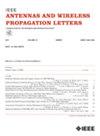A High-Gain Filtering DDPA With a Four-Slot Feed Structure Based on High-Order Modes
IF 3.7
2区 计算机科学
Q2 ENGINEERING, ELECTRICAL & ELECTRONIC
引用次数: 0
Abstract
In this letter, a high-gain filtering dense dielectric patch (DDP) antenna (DDPA) based on high-order modes is proposed. The feed structure is composed of four slots and a U-shaped microstrip line. The基于高阶模态的四槽馈电结构高增益滤波DDPA
本文提出了一种基于高阶模态的高增益滤波稠密介电贴片(DDP)天线。进给结构由四个槽和一条u型微带线组成。成功激活DDP的$TE_{12} $、$TE_{12+ \delta } $和${TE}_{13} $模式。基于三种高阶模式,设计的滤波DDPA实现了高增益。通过在地面和非辐射模式上蚀刻平行的四槽结构产生辐射空值(Null 1和Null 2)。通过在DDP上刻蚀矩形凹槽,采用倒l型缺陷结构,并在微带线上附加c型短段,获得了较好的阻抗匹配和阻带抑制水平。为了验证设计,制作并测量了所提出的滤波DDPA,样机的轮廓仅为${\text{0.069}}\lambda _{0}$。测量结果表明,相对阻抗带宽为13.2% [(4.6 to 5.25) GHz]. The measured average realized gain and peak gain are 8.66 dBi and 9.85 dBi, respectively. The filtering DDPA has high-gain, wide passband, and good edge selectivity.
本文章由计算机程序翻译,如有差异,请以英文原文为准。
求助全文
约1分钟内获得全文
求助全文
来源期刊
CiteScore
8.00
自引率
9.50%
发文量
529
审稿时长
1.0 months
期刊介绍:
IEEE Antennas and Wireless Propagation Letters (AWP Letters) is devoted to the rapid electronic publication of short manuscripts in the technical areas of Antennas and Wireless Propagation. These are areas of competence for the IEEE Antennas and Propagation Society (AP-S). AWPL aims to be one of the "fastest" journals among IEEE publications. This means that for papers that are eventually accepted, it is intended that an author may expect his or her paper to appear in IEEE Xplore, on average, around two months after submission.

 求助内容:
求助内容: 应助结果提醒方式:
应助结果提醒方式:


